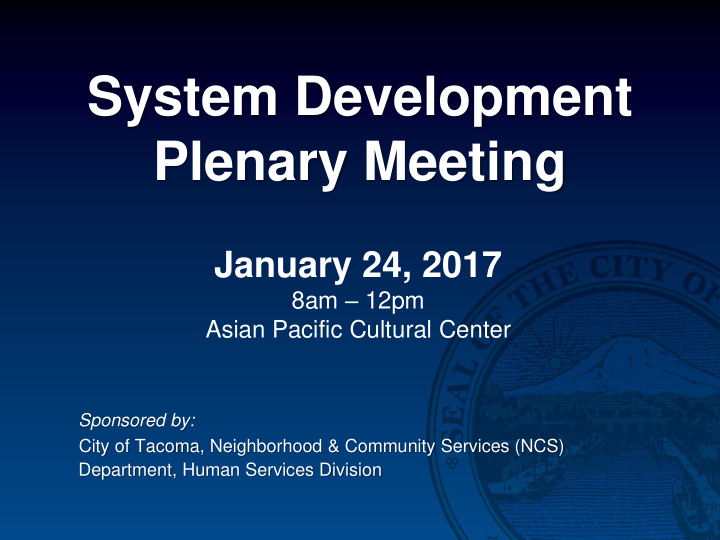



System Development Plenary Meeting January 24, 2017 8am – 12pm Asian Pacific Cultural Center Sponsored by: City of Tacoma, Neighborhood & Community Services (NCS) Department, Human Services Division
Agenda Introductions (8 – 8:15am) Getting to Know You (8:15 – 8:30am) Setting the Stage: Big Picture Overview (8:30 – 10am) BREAK (10 – 10:15am) Organizing Efforts: Impact Area Breakout Sessions (10:15 – 11:30am) Report Out (11:30 – 11:45am) Closing & Next Steps (11:45 – 12pm) 2
Unique & Shared Exercise Please form groups (10 people each) F ind out… - What are 5 things that everyone has in common? - What are 5 things that are true for only one person? EXPLORE BELOW THE SURFACE! 3
Setting the Stage Big Picture Overview Multiple layers of strategic planning PIVOT POINT: 2016 Community Needs Assessment – Identified current needs and gaps New Business Model & Funding Approach – Maslow’s Hierarchy of Needs 4
Tacoma 2025 Human Services Strategic Plan Vertical Alignment Community Needs Assessment NCS Goals & Measures Impact Areas & Issue Statements Common Measures Alignment Across Programs / Partners
Tacoma 2025 Core Values: Opportunity, Equity, Partnerships, Accountability Seven Focus Areas – Health and Safety – Human and Social Needs – Economic Vibrancy and Employment – Education and Learning – Arts and Cultural Vitality – Natural and Built Environment – Government Performance 6
2015- 2019 Human Services Strategic Plan Meet Basic Needs of Tacoma Residents Prepare Children and Youth for Success Increase Employability, Determination, and Empowerment for Adults Enhance Mental Health and Substance Use Disorder Services 7
Community Needs Assessment (2016) Three Primary Topics – Homelessness & Household Stability – Workforce Development – Human & Social Wellness Priority Community Needs – Childhood Poverty – Mental Health – Household Stability 8
NCS Department Goals 1. Increase the feeling of safety for individuals and neighborhoods 2. Increase the equity of service delivery and increase accessibility 3. Decrease the length of time individuals experience homelessness 4. Increase the availability and accessibility of safe and affordable housing* 5. Decrease the number of families and 9 individuals living below the poverty line
NCS Performance Measures 1. Reduce substandard and derelict building cases and eliminate chronic encampments 2. Utilization of services by underrepresented communities 3. Average shelter stay and the number of returns to homelessness 4. Establish baseline data and define affordable housing options* 10 5. Number of families living in poverty
Questions? Comments? 11
New Business Model & Funding Approach Three I MPACT AREAS Impact Area ISSUE STATEMENT – Describes the issue(s) – Identifies FOCUS AREAS – Identifies FUNDING PRIORITIES (specific services city is funding in 2017-2020) within the Focus Areas 12
The Components • Human Services Impact Area • Issue Statement • Human Services Focus Areas • Human Services Funding Priorities (2017 – 2020 Services) 13
HUMAN SERVICES IMPACT AREAS Homelessness & Opportunity & Social Wellness Household Stability Achievement Mental Health & Substance Use Disorder QUALITY OF LIFE CONTINUUM 14 14 14
15
HHS Example Impact Area Focus Areas Funding Priorities Solutions to eliminate Homelessness Homelessness street homelessness and Household o Street outreach Stability o Emergency shelter o Prevention o Diversion o Complimentary Services Solutions to housing youth and young adults o Street outreach o Emergency Shelter o Prevention 16 o Diversion o Complimentary Services
Questions? Comments? 17
Performance Measures: A Brief History of Outcome Based Evaluation (OBE) 18
19
20
21
Measurement Tool Types Case records Interviews Agency developed observation tools Modified observation tools Standardized observation tools Official records Agency developed surveys Modified surveys Surveys that were not piloted Standardized surveys 22
Questions? Comments? 23
Collective Impact Intended to help communities come together to address significant social issue(s) – Common Agenda – Mutually Reinforcing Activities – Shared Measurement – Continuous Communication – Backbone Support 24
Common Agenda S takeholders agree on… – Issue(s) that need to be addressed – Root Causes ( not just symptoms ) – The End Game – Goals and Strategies 25
Mutually Reinforcing Activities Stakeholders agree on… – How to best work together to achieve the common agenda (who, what, when, where, and how) – How to maximize existing community resources / assets 26
Shared Measurement S takeholders agree on… – Common Performance Measures • Population Level • Program/Service Level • Process Level – Data Collection & Analysis System 27
Continuous Communication S takeholders agree to… – Continually communicate across the entire initiative • Consistent Terminology • Timely Data & Information Sharing • Opportunities to reflect, learn and adjust course 28
Backbone Support S takeholders agree to… – Contribute the needed infrastructure to ensure success • Convening & Facilitation • Data Repository • Keeper of the Process, History, Agreements, etc. • Fund & Resource Development 29
Questions? Comments? 30
Envisioned Roles & Structure City will serve as the primary SPONSOR to help launch the system development efforts (2017) Goal is WE, not CoT – Steering Committee – Focus Area Workgroups – Other Coalition / Initiatives 31
Envisioned Roles & Structure Steering Committee 11 – 15 individuals representing a cross-sector of the Tacoma / Pierce County community to provide strategic level guidance during the launch period (2017) 32
Envisioned Roles & Structure Focus Area Workgroups Individuals representing a cross- sector of the Tacoma / Pierce County community, including service providers funded under the city’s Funding Priorities, to help develop common performance measures across like-services 33
Envisioned Roles & Structure Target Stakeholders • Service Providers (3 Impact Areas) • Service Recipient(s) • Community (incl. HSC) • Government • Business • Funders • Churches/Faith-Based Organization • Partner Coalitions/Initiatives 34
Questions? Comments? 35
IMPACT AREA BREAKOUT SESSIONS (10:15 – 11:30am) 36
Impact Area Breakout Sessions REPORT OUT 37
Closing Thoughts & Next Steps What We Learned Today Future Plenary and Focus Area Workgroup Meetings NCS Website Materials 38
Please remember to… Sign up for at least one (1) Focus Area Workgroup Complete the Meeting Feedback Survey Thank you for attending today! 39
Recommend
More recommend